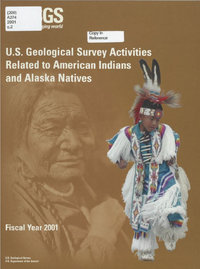U.S. Geological Survey Activities Related to American Indians and Alaska Natives Fiscal Year 2001
Links
- More information: Publisher Index Page (via DOI)
- Document: Report (pdf)
- Download citation as: RIS | Dublin Core
Abstract
Information is a resource that can help Native American governments and their people. The U.S. Geological Survey (USGS) makes available technical expertise, reports, and other impartial information sources that can benefit Native Americans interested in subsistence issues, water, land use, and the health of many parts of the environment.
The USGS works in cooperation with American Indian and Alaska Native governments, conducting research on water and mineral resources, animals and plants of environmental, economic, or subsistence importance, natural hazards, and geologic resources. Digital data on cartography, mineral resources, stream flow, biota, and other topics are available to American Indian and Alaska Native individuals and institutions. The USGS recognizes the need to learn from and share knowledge with Native peoples. This report describes most of the activities that the USGS conducted with American Indian and Alaska Native governments, educational institutions, and individuals during Federal fiscal year 2001. Some of these USGS activities were carried out in concert with the Bureau of Indian Affairs (BIA). Others were conducted by Tribes and the USGS.
In 2001, the USGS began examining its activities related to American Indians and Alaska Natives to determine how it can better serve these customers within its mandates. A growing number of Tribal governments, educational institutions, and other Tribal organizations have begun using geographic information systems and other digital technologies in recent years. As Tribes become more interested in and more adept at managing digital information, they are seeking relevant data from the USGS more frequently. Using digital technologies provides Tribal governments with additional means of managing lands and resources for the benefit of current and future generations. The USGS recognizes the need to make its information available to Tribal governments, and to work with those governments and other institutions to advance data management capabilities.
The USGS is responding to this need by increasing the transfer of scientific information to American Indian and Alaska Native governments and by training employees of those governments to conduct and improve scientific studies. The USGS is also encouraging American Indians and Alaska Natives to pursue careers in science, and seeking ways to hire Indian and Native students. By identifying, improving, and disseminating information about available hiring mechanisms, the USGS is working to make hiring such students easier, and therefore more likely, for USGS managers.
The U.S. Geological Survey is the Federal science bureau within the Department of the Interior (DoI). The USGS is non-regulatory and is not a significant manager of Federal or Trust lands or assets. However, there are two types of USGS activities that do involve American Indians, Alaska Natives, and their lands.
The first type of activity is the course of formal studies, conducted through existing USGS programs, that involves collection of specific types of data as well as investigative and research projects. These projects typically last 2 or 3 years, although a few are parts of longer-term activities. Some projects are funded through cooperative agreements, from monies provided to the USGS by individual Tribal governments or by the BIA. The USGS provides matching funds for cooperative projects. These formal projects may also receive funding from the U.S. Environmental Protection Agency, the Indian Health Service (part of the Department of Health and Human Services), or other Federal agencies. The USGS routinely works with its sister bureaus in the Department of the Interior to provide the scientific information and expertise needed to meet the Department's science priorities. Within this context, the USGS and the BIA are cooperating to use USGS information resources to benefit American Indian and Alaska Native peoples and their lands.
The second type of USGS activity is less formal, based on initiatives designed and conducted by USGS employees. Frequently involving educational activities, these endeavors are prompted by employee interests, often as collateral issues, that result from one or more USGS employees identifying and responding to an observed need. In these activities, USGS employees help fulfill a mission of the USGS-to make science relevant-while helping their fellow citizens. USGS employees have also taken the initiative in assisting American Indians and Alaska Natives through participation in several organizations that were created to foster awareness of science among Native peoples and to help build support and communication networks. One such group is the American Indian Science and Engineering Society (AISES). This group sponsors an annual national meeting in which USGS employees participate. USGS employees join this organization on a voluntary basis, bringing the benefits of this expanded network to the USGS, as many employees do with other professional organizations.
Each part of the USGS has identified an American Indian/Alaska Native liaison. Furthermore, the USGS has instituted a regional organizational structure, with Western, Central, and Eastern Regions. The regions work in concert with specific scientific disciplines to conduct the scientific mission of the USGS. The regional structure is intended to bring us closer to our customers; we hope that Native Americans and Alaska Natives will use the contacts listed at the end of this report.
| Publication type | Report |
|---|---|
| Publication Subtype | USGS Unnumbered Series |
| Title | U.S. Geological Survey Activities Related to American Indians and Alaska Natives Fiscal Year 2001 |
| DOI | 10.3133/70038036 |
| Year Published | 2001 |
| Language | English |
| Publisher | U.S. Geological Survey |
| Publisher location | Reston, VA |
| Description | xiii, 55 p. |


